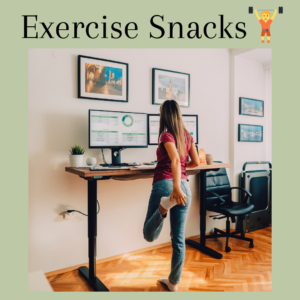It’s no surprise that we are more sedentary than ever these days. With cars, desk jobs, Amazon Prime, and Uber Eats, most of us have no pressing reason to get up and move because everything we need is within our grasp. More research continues to highlight the detrimental effects of a sedentary lifestyle, and yet, our lives become busier and busier with career, family, and friend obligations. So, how do we remedy this when we know we need to move but are stuck sitting at our desk job all day?
A possible cure for the sitting epidemic?
The answer: Exercise snacks! Unfortunately, this term does not mean you get to eat tasty snacks while working out (I wish). Exercise or “activity snacks” is a term coined by researchers to describe breaking up long bouts of sitting/inactivity with interspersed movement. For you Apple Watch users, you might be familiar with this concept each time your wristwatch buzzes and tells you to stand up every hour.⌚
The benefits of exercise snacks seem too good to be true, but they have been shown to improve glucose tolerance and maintain the rate of muscle protein synthesis even when sitting for long periods.
What does the research say?
A 2022 randomized control trial took 12 men and women and had them:
- sit for 7.5 hours straight
- sit for 7.5 hours, and perform 15 bodyweight squats every 30 minutes
- sit for 7.5 hours, and walk for 2 minutes every 30 minutes
The researchers measured the amount of amino acids incorporated into myofibrillar protein (a fancy way of saying how much protein we eat is incorporated into muscle mass) and myofibrillar protein synthesis (MPS). MPS is important because an increase in muscle protein synthesis will improve strength and contribute to building muscle mass.
Protein and exercise are two ways to increase muscle protein synthesis, so this study looks at how much exercise you really need to stimulate MPS. Interestingly, it seems like you don’t have to spend hours in the gym to achieve this goal. The researchers found there was an increase in myofibrillar protein and MPS in the bodyweight squat and walking groups. In fact, the MPS rate was actually higher in the group doing short bursts of walking compared to the bodyweight squat group.
Note: This study was done on inactive (less than 150 min of activity per week) young adults (~23 years old). Research has shown that younger people have an easier time gaining muscle mass, so it would be interesting to see this study repeated on older folks or trained/active individuals.
What does this mean for me?
This means that even if you work a sedentary job or can’t find much time in the day to work out, you can still do something to improve your health.
You can take a lap around your office every hour or even do seated calf raises underneath your desk (there is a fantastic study on this). Any bit of movement can help counteract some of the negative effects of sitting for so long. The key is to be consistent and get in some kind of movement each hour.
Of course, if your goal is to build and increase your muscle mass, you’re going to need more muscle stimulation than just exercise snacks. Although, it’s a great place to start if you’re new to exercising or just in a busy season of your life. Try incorporating activity snacks into your day as a stepping stone to creating a workout routine. 🏋️
Remember, protein and exercise contribute to increasing MPS, so if you are lacking on the exercise part of the equation, it’s even more important to prioritize high-quality protein in your diet. I can write more about the incredible benefits of getting enough protein and resistance training in another post. Until next time, I hope you enjoyed this mini-research review!
